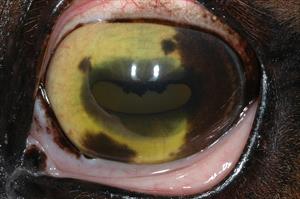Uveitis blue iris to yellow-green

With uveitis, this horse's blue iris turns into a yellow/green color. Photo by Dr. Erica Tolar
Equine recurrent uveitis (ERU) is the most common cause of blindness in horses. As many as 28 percent of horses were blind in one or both eyes when first examined by an ophthalmologist. ERU is often referred to as moon blindness. It was originally thought that these episodes of inflammation, or uveitis, occurred with the phases of the moon. It is true that ERU is characterized by recurring bouts of inflammation but they do not correlate to the phases of the moon.
Equine recurrent uveitis is thought to be an autoimmune disease but the underlying cause and reasons for recurrence have not been completely elucidated. Just because a horse has an episode of inflammation, or uveitis, does not mean they have ERU. There are many causes of uveitis, which can in turn result in equine recurrent uveitis if not managed appropriately.
Leptospirosis is the most common and well-known infectious organism associated with ERU but the clear association and development of it is still not well understood. Leptospirosis is a bacterial disease and the organisms are found in rivers, lakes and pond waters as well as sewage. Deer, cattle, pigs and rats are the animals that carry the organism that infects horses. Horses are infected with this bacterium after drinking water that has been contaminated by urine from one of the above listed animals. Horses should not be allowed to drink water from ponds or run off areas; rather they should use a designated water trough. Initial infection with the bacteria is often not noticed but the ocular signs can occur immediately or within 15 to 24 months.
Appaloosa, Warmblood and Knabstrupper horses are thought to have a genetic predisposition to ERU. The disease in these breeds is more of an insidious type of inflammation with chronic low-grade inflammation. These horses are not obviously painful. Appaloosas with the leopard complex are eight times more likely to develop equine recurrent uveitis and four times more likely to go blind than any other breed.
Differentiating between ERU and non-ERU uveitis is important. There are many ocular conditions with similar symptoms; squinting, tearing, corneal cloudiness and even blindness. Treatment options vary widely between ERU and non-ERU uveitis.
The initial goal with ERU is to get the inflammatory episode and pain under control. This can be done with topical or oral steroid or nonsteroidal anti-inflammatories, intravitreal injections of low dose gentamicin and/or triamcinolone, suprachoroidal cyclosporine implants, and vitrectomy. There are pluses and minuses to each treatment plan; discussion with your doctor and ophthalmologist will help you choose the best one for you and your horse.